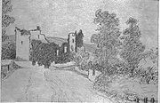
Kilbirnie
Encyclopedia
Kilbirnie is a small town of 7280 (2001 census) inhabitants situated in North Ayrshire
on the west coast of Scotland
. Historically, the town built up around the flax
and weaving
industries before iron
and steelmaking
took over in the 19th and early 20th centuries.
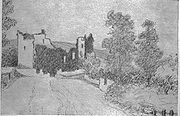 Kilbirnie derived its name from the parish church
Kilbirnie derived its name from the parish church
and the church obtained its name from the saint to whom it was dedicated; the celtic
Cil, pronounced Kil, signifying a church, being prefixed to the name of the saint; St Birinie, or Birinus
, is said to have been a bishop
and confessor
who converted the West Saxons. He died at Dorchester
in 650 AD and was commemorated on the 3rd of December. In the vicinity of the church of Kilbirnie, a village has arisen during late times. In 1740, there were only three houses; but, by means of manufactures, it grew to be a village of 80 houses which were inhabited by about 300 people in 1791. In 1821, the village of Kilbirnie contained about 800 people, thanks to the impulse given to the locality by the Ayr
and Glasgow
railway, and the vicinity of numerous ironworks
. Since Kilbirnie was not a large town before the 1840s, there is not much written history except for the farms in the area. However, documentation from the witch trials does name William Semple (or Sempill) as being arrested for being a witch. The documentation does not state if he was burned or not.
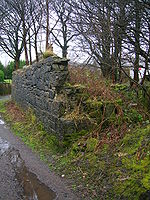 Glengarnock Steel Works opened its blast furnaces around 1841 which caused a massive influx of people from all over the country, as well as all over the world. Initially these works were owned by Merry & Cunninghame before being taken over by David Colville & Sons and eventually nationalised as part of British Steel
Glengarnock Steel Works opened its blast furnaces around 1841 which caused a massive influx of people from all over the country, as well as all over the world. Initially these works were owned by Merry & Cunninghame before being taken over by David Colville & Sons and eventually nationalised as part of British Steel
and finally closed in 1985. The steelworks in Glengarnock provided employment mostly for the men of the community, whilst the W & J Knox Threadmills in Kilbirnie provided work mainly for women.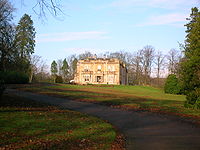 The entire collection of staff magazines from the Merry & Cunninghame to Colvilles days of the steelworks at Glengarnock have been preserved and are held at the Mitchell Library
The entire collection of staff magazines from the Merry & Cunninghame to Colvilles days of the steelworks at Glengarnock have been preserved and are held at the Mitchell Library
in Glasgow. This provides content such as spotlights on employees and departments, and contains photographs over 100 years old.
W & J Knox Threadmills were owned by the Knox family who were very prominent, not only in Ayrshire but in the South of England too, with their families becoming important members of society. Some of the mansion houses they built were: Moorpark (once home of Robert William Knox); Redheugh (once home of Hugh Knox); Knoxville (on Knoxville Road); and Place (home of Sir James Knox and Sir Charles and Lady Mathew, his son-in-law), which has since been demolished. The second of the three cemeteries in Kilbirnie contains an underground vault where the family are buried, next to the main Knox monument. These mills were famous for their nets, used by the British Army
as well as the British Telecom Tower
in London, for example. Numerous associations to the family can be found around the town. The Knox Institute which sits above shops at the bridge was donated by a member of the Knox family and housed Kilbirnie's first public library.
World War I
veteran and hero General Mathew married into this family and lived at "Place". Who's Who
editions of the period list many members of the family and give further information on knighthoods, etc.
spectrum with one Brethren Assembly (and also one in Glengarnock), two Church of Scotland
churches, Jehovah's Witnesses
meeting room (Glengarnock), Salvation Army
Citadel and a Roman Catholic church, as well as links to evangelical
groups. The Mission Hall has been demolished in recent years.
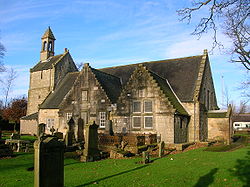
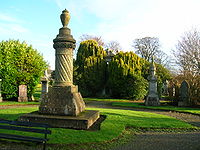 The Kirk
The Kirk
"Auld Kirk" is one of the oldest churches still in use both pre- and post-Reformation
. The Kirk
is a tourist attraction, containing the Crawfurd Gallery, as well as a mausoleum
to the Crawfurd family in its grounds. Crawfurd Castle at "Place" remains in ruins. Robert Burns
allegedly came to the blacksmiths near the Kirk. Opposite the church sits one of the oldest surviving farmhouses on the corner. A book is available on its history by John Lachland. It is from this site of the present church that Kilbirnie takes its name. Guided tours are run at specified times.
have been reduced since ten years ago. The Roman Catholic Primary School is known as "St Bridgets". It is unclear how the first priest, Father Thomas P Lee, raised enough money to build the church. Initially, it was intended to be built in the public park, across from what was the original Church House residence of the Priest. Father Lee was sent as a missionary
priest from All Hallows College
, Dublin and was initially based in Johnstone
, as Kilbirnie fell within the archdiocese of Glasgow in those days.
Father Thomas P Lee, a young Irish priest, was sent in 1859 to be the resident priest in Kilbirnie. Somehow he raised the money and land to build his church and chose St. Brigid (devotion to the poor) to be the patron saint of the parish. Opened in 1862, the modest structure was a Gothic styled rectangular building with a gallery, porch, vestry, confessional and a related presbytery.
Due to an increasing post war population it was decided to renovate and enlarge the old church. The plan provided for an extension to the rear of the existing church, and when the work was completed there would be a new sanctuary and sacristy with accommodation for the altar boys. In front a new porch and baptistery were added to the old structure. The renovated and expanded church was opened in 1957. Conveniently the schoolmaster's house next door was also purchased to replace the more distant presbytery on Parkhouse Drive.
Retrieved from "http://en.wikipedia.org/wiki/St_Brigid%27s_Church,_Kilbirnie"
Although the date of the first meeting for the breaking of bread is given as 1889, the circumstances leading up to the commencement go back about seven years earlier, when what was then known as the Blue Ribbon Gospel Army—which had its headquarters in London—came to the village. Gospel meetings were begun in the Good Templars’ Hall (Now a carpet shop, once the DSS office) which was hired for the occasion. This new departure in religious services received a rather mixed reception, and from the start was met with opposition. Nevertheless, large numbers gathered to hear the itinerant preachers. On the night previous to the opening meeting there had been a theatrical performance in the hall, and the scenery was still in position on the Sunday night. Thus amid these surroundings the Gospel was preached to a crowded audience and a remarkable work was begun. Almost from the opening meeting the power of the Holy Spirit became manifest, and many who came to those services indifferent as to spiritual matters, but curious to know what was going on, had their consciences awakened and were led to "put their trust in the Saviour". Soon afterwards was known the assembly in Kilbirnie, which at that time had amongst its leaders such men as John Barclay and John Peebles.
At the close of the mission the young converts came together with the object, not only of continuing the Gospel testimony but for the study of the Scriptures. This spiritual exercise of soul led a number of them to the truth of believers’ baptism and the remembrance of the Lord’s Supper. Not all of those who up to that time had been united in the work of the Gospel, could see their way to sever a connection with the denominations to which they were still attached. This meant a separation which was keenly felt on either side. The first company that came together to remember the Lord numbered fifteen. It may have been observed in following the course of assembly life in Scotland, that a notable feature of Gospel activity has been the conducting of kitchen meetings during the winter months. And many a Gospel preacher whose name is familiar amongst us to-day, received his early training at those homely gatherings, where anxious souls were won for the Master, and where it was indeed a rare occasion that the Holy Spirit’s power could not be felt in a very real way. In the early days aggressive Gospel work, mainly in the kitchens of the working-class people, was an outstanding characteristic of Kilbirnie, and the remarkable development of the assembly and Sunday School is due in no small measure to this particular activity.
From Kilbirnie there went forth missionaries in the foreign field: James Clifford, Argentine; Matthew Brown, India; Dr. Robert Kennedy, West Indies; and Miss Maggie Barclay, Central Africa.
called James (Jaime) Clifford. Born in Kilbirnie in 1872, he worked as a child in the coal mines. His oratory skill was such that the Independent Labour Party tried to recruit him as a potential MP, but he turned down the offer, choosing Christian mission life instead. He remained a defender of labour workers throughout his life.
James Clifford first moved to Argentina in 1896 where he did pioneering work for the Brethren movement. During the first world war he lived in Britain and went back after the war to his missionary work in Tucuman in the north of Argentina
. In the early 1930s he moved to Cordoba, Argentina
for health reasons. He died in 1936. One of his sons Alejandro Clifford (1907–1980) was a Christian writer and editor in South America
His other son Juan Clifford (1909–1992)was for many years the Manager for Northeast Argentina of the Argentine Bible Society.
Kilbirnie was the birthplace of James Clifford, whose Home-call, at the close of forty years’ service for the Lord in South America, removed a prominent figure from the great harvest field. The little but-and-ben in which he was reared, stood on the ground now occupied by the Kilbirnie Assembly Gospel Hall. Jamie was saved in the old Free Kirk during a special mission by the Ayrshire Christian Union. He was then in his early teens. Very early in his Christian experience Jamie manifested a keen desire to serve the Lord, and entered wholeheartedly into the many activities of the assembly. Of a genial and kind disposition, his life was characterised by a sincerity of purpose which marked him out as a chosen vessel, eminently suited for the great work to which in later years he was called.
The life work of James Clifford, across the measureless tracts ‘of the Argentine, which constituted his vast parish, is so well known that it is necessary only to make a passing reference here. From a fellow-labourer comes this testimony: “He was known and beloved from the Bolivian border in the north, right to Montevideo, one hundred miles beyond Buenos Aires up the River Plate: over a thousand miles! He had a knowledge of the Scriptures that enabled him always to minister and refresh and build up the saints, with such ministry as was invaluable.” James Clifford lived to see the fruitful results of his labours in a great ingathering of souls, and in the establishment of assemblies of Christian believers throughout the country.
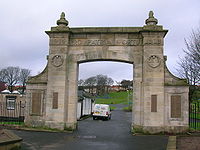 Amongst many other old buildings in the Town, stands the "Walker Hall", a memorial hall dedicated to Dr Walker, one of the first physicians in the town. In the 1950s and 1960s this was very famous as a dance hall, coming second only to Glasgow Barrowlands itself. Famous bands to play there included Gerry & The Pacemakers
Amongst many other old buildings in the Town, stands the "Walker Hall", a memorial hall dedicated to Dr Walker, one of the first physicians in the town. In the 1950s and 1960s this was very famous as a dance hall, coming second only to Glasgow Barrowlands itself. Famous bands to play there included Gerry & The Pacemakers
and Bill Haley & His Comets
. In the 1980s it housed a market roughly once a week, though these days it houses the town's Citizens Advice Bureau
and is regularly the venue for meetings, concerts and wedding receptions.
Other sources of entertainment in the 1950s and 1960s included two cinemas, both of which have long since closed. One of these cinemas is now the home of Radio City
. The Association which formed Radio City was set up in early 1998 to identify ways of providing both much needed local facilities and a use for the disused former cinema which occupies a prime site in Kilbirnie town centre. During the 1997 election campaign, MP Brian Wilson had met with a group of local teenagers who had stressed the need for local facilities, and, with the help of Largs architect Paddy Cronin, plans were developed to provide a Healthy Living Centre which would include fitness facilities, internet access, a healthy eating cafe and child care. Bids for funding were made to both private and National Lottery
organisations. The original steering group included Allan Wilson
, Jim Stevens, Greta Jennings (now chair of the Company), John Bell (now a local councillor and also treasurer of the Company), Douglas and Brian Johnstone, Derek Clarkson, Agnes Walsh, Ian Gemmill, Ken James, and George Stevens.
(Beith). Initially the school operated from the four sites moving to the new building on School Road in September 1972. It is a non-denominational co-educational school serving Beith
, Dalry, Gateside, Glengarnock
, Kilbirnie and the surrounding area.
Moorpark Primary School, accessed from Milton Road by the students, was opened in 1978 to replace Ladyland School built in 1869 and Bridgend School built in 1893. The school is located east of its namesake Moorpark House and adjoining Garnock Academy.
The new Glengarnock Primary School, built on the site of the 1923 wooden expansion on Grahamstone Avenue, came into use in 1992 to replace the original 1863 sandstone building, formerly across the Garnock River on Main Street, Glengarnock.
Saint Bridget's Primary School on Hagthorne Avenue serves the needs of local Roman Catholic children . This location opened in October 1963 replacing the 1894 building on Avil's Hill. Secondary level Catholic pupils currently attend the new supersecondary building in Saltcoats. Over time, the spelling of St Brigid seems to have been transformed to Saint Bridget.
Kilbirnie Central School had been used at different times for both primary and secondary education. The building, which opened in 1921, was demolished in 1992 and a new health centre opened on the site in 1994.
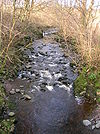 The River Garnock
The River Garnock
flows from the base of the Hill of Stake in a southerly direction, traversing Kilbirnie and Glengarnock, and making its way to Irvine Harbour where it enters the sea.
is Glengarnock Castle
, a ruined 15th century keep. Ladyland Castle
, mostly demolished, lay nearby and Ladyland House still survives as designed by David Hamilton
.
On 1 August 2008, the River burst its banks and the local police station needed to be evacuated. Mill Road, Muirend Street, Kilbirnie Bowling Club, Radio City and the local Tesco were all affected by the flooding with waters reaching one metre deep in places.
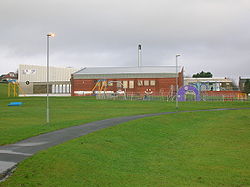 Kilbirnie has very few local employers, and people generally travel out of the town for work.
Kilbirnie has very few local employers, and people generally travel out of the town for work.
Landmarks of interest include Kilbirnie Loch
, a mile and a half long and nearly half a mile broad. It is a well-used local amenity catering for diverse sporting activities such as fishing, jet skiing and rugby (played on the playing fields at the loch shore edge). Part of the area around the Loch is sliding possibly due to the old mining shafts under the area or the activities which took place there with the steel manufacturing. A portion of the loch was filled in with waste slag etc. from the old steelworks, giving the loch shore in parts a very artificial nature.
Kilbirnie itself does not have many hotels or places for guests to stay, although recently Moorpark House has reopened as a luxury hotel, and other tearooms and places to eat are opening. There are a number of bed and breakfast establishments in the area and tourists could also stay at Largs (a busy seaside resort close by) or in one of the rural guest houses nearby. The Milton Hotel, which once existed in Cochrane Street, burned down in the 1980s and has been redeveloped as social housing.
The loch used to be known as Lochthankart and has its main source, the Maich Water, entering unusually at the same end as the Dubs Water which drains it.
Full Monumental Inscriptions can be found in the local library or else at the North Ayrshire Heritage Centre in Saltcoats.
Since the town did not expand until the 1840s most families who lived in Kilbirnie had their roots elsewhere and came to Kilbirnie to find work, such as mining and the steelworks.
which has many headstones dating from the mid 17th century including the Crawfurd Mausoleum. Some headstones are marked with a skull and cross bones, and are believed by some to denote graves of pirates but it is likely that this old symbol was appropriated by them to put fear into those visiting. The next graveyard extends to the south on Kirkland Road and has headstones from the mid 19th century onwards, reflecting names from the industrial period of the town, such as Doctor Walker and Sir James Knox. Further south beyond the former railway embankment is the newest cemetery which opened in 1950.
was part of the Dalry and North Johnstone Line on the Glasgow and South Western Railway
. The station opened on 1 June 1905, and closed to passengers on 27 June 1966. The station's island platform remains in place and intact; the trackbed is now part of the Sustrans
National Cycle Route 7. Kilbirnie South railway station
served Kilbirnie as part of the Lanarkshire and Ayrshire Railway (L&AR). The station opened 2 December 1889 as Kilbirnie. Upon the grouping of the L&AR into the London, Midland and Scottish Railway (LMS) in 1923, the station was renamed Kilbirnie South on 2 June 1924. The station closed to passengers and freight on 1 December 1930. A photograph of 1936 shows that the station remained intact but was already overgrown, however Nothing remains of the station today.
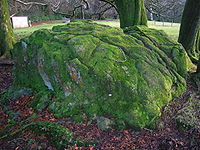

North Ayrshire
North Ayrshire is one of 32 council areas in Scotland with a population of roughly 136,000 people. It is located in the south-west region of Scotland, and borders the areas of Inverclyde to the north, Renfrewshire to the north-east and East Ayrshire and South Ayrshire to the East and South...
on the west coast of Scotland
Scotland
Scotland is a country that is part of the United Kingdom. Occupying the northern third of the island of Great Britain, it shares a border with England to the south and is bounded by the North Sea to the east, the Atlantic Ocean to the north and west, and the North Channel and Irish Sea to the...
. Historically, the town built up around the flax
Flax
Flax is a member of the genus Linum in the family Linaceae. It is native to the region extending from the eastern Mediterranean to India and was probably first domesticated in the Fertile Crescent...
and weaving
Weaving
Weaving is a method of fabric production in which two distinct sets of yarns or threads are interlaced at right angles to form a fabric or cloth. The other methods are knitting, lace making and felting. The longitudinal threads are called the warp and the lateral threads are the weft or filling...
industries before iron
Iron
Iron is a chemical element with the symbol Fe and atomic number 26. It is a metal in the first transition series. It is the most common element forming the planet Earth as a whole, forming much of Earth's outer and inner core. It is the fourth most common element in the Earth's crust...
and steelmaking
Steelmaking
Steelmaking is the second step in producing steel from iron ore. In this stage, impurities such as sulfur, phosphorus, and excess carbon are removed from the raw iron, and alloying elements such as manganese, nickel, chromium and vanadium are added to produce the exact steel required.-Older...
took over in the 19th and early 20th centuries.
History

Kilbirnie Auld Kirk
Kilbirnie Auld Kirk is a Church of Scotland congregation on Dalry Road , Kilbirnie, North Ayrshire, Scotland. Although the building dates back to the 15th century, the present congregation was formed in 1978 by the amalgamation of Glengarnock Parish Church and the The Barony Church.- History...
and the church obtained its name from the saint to whom it was dedicated; the celtic
Celtic languages
The Celtic languages are descended from Proto-Celtic, or "Common Celtic"; a branch of the greater Indo-European language family...
Cil, pronounced Kil, signifying a church, being prefixed to the name of the saint; St Birinie, or Birinus
Birinus
Birinus , venerated as a saint, was the first Bishop of Dorchester, and the "Apostle to the West Saxons".-Life and ministry:After Augustine of Canterbury performed initial conversions in England, Birinus, a Frank, came to the kingdoms of Wessex in 634, landing at the port of "Hamwic", now in the...
, is said to have been a bishop
Bishop
A bishop is an ordained or consecrated member of the Christian clergy who is generally entrusted with a position of authority and oversight. Within the Catholic Church, Eastern Orthodox, Oriental Orthodox Churches, in the Assyrian Church of the East, in the Independent Catholic Churches, and in the...
and confessor
Confessor
-Confessor of the Faith:Its oldest use is to indicate a saint who has suffered persecution and torture for the faith, but not to the point of death. The term is still used in this way in the East. In Latin Christianity it has come to signify any saint, as well as those who have been declared...
who converted the West Saxons. He died at Dorchester
Dorchester, Oxfordshire
Dorchester-on-Thames is a village and civil parish on the River Thame in Oxfordshire, about northwest of Wallingford and southeast of Oxford. Despite its name, Dorchester is not on the River Thames, but just above the Thame's confluence with it...
in 650 AD and was commemorated on the 3rd of December. In the vicinity of the church of Kilbirnie, a village has arisen during late times. In 1740, there were only three houses; but, by means of manufactures, it grew to be a village of 80 houses which were inhabited by about 300 people in 1791. In 1821, the village of Kilbirnie contained about 800 people, thanks to the impulse given to the locality by the Ayr
Ayr
Ayr is a town and port situated on the Firth of Clyde in south-west Scotland. With a population of around 46,000, Ayr is the largest settlement in Ayrshire, of which it is the county town, and has held royal burgh status since 1205...
and Glasgow
Glasgow
Glasgow is the largest city in Scotland and third most populous in the United Kingdom. The city is situated on the River Clyde in the country's west central lowlands...
railway, and the vicinity of numerous ironworks
Ironworks
An ironworks or iron works is a building or site where iron is smelted and where heavy iron and/or steel products are made. The term is both singular and plural, i.e...
. Since Kilbirnie was not a large town before the 1840s, there is not much written history except for the farms in the area. However, documentation from the witch trials does name William Semple (or Sempill) as being arrested for being a witch. The documentation does not state if he was burned or not.
Industry

British Steel
British Steel was a major British steel producer. It originated as a nationalised industry, the British Steel Corporation , formed in 1967. This was converted to a public limited company, British Steel PLC, and privatised in 1988. It was once a constituent of the FTSE 100 Index...
and finally closed in 1985. The steelworks in Glengarnock provided employment mostly for the men of the community, whilst the W & J Knox Threadmills in Kilbirnie provided work mainly for women.

Mitchell Library
The Mitchell Library is a large public library and centre of the public library system of Glasgow, Scotland.-History:The library was established with a bequest from Stephen Mitchell, a wealthy tobacco manufacturer, whose company, Stephen Mitchell & Son, would become one of the constituent members...
in Glasgow. This provides content such as spotlights on employees and departments, and contains photographs over 100 years old.
W & J Knox Threadmills were owned by the Knox family who were very prominent, not only in Ayrshire but in the South of England too, with their families becoming important members of society. Some of the mansion houses they built were: Moorpark (once home of Robert William Knox); Redheugh (once home of Hugh Knox); Knoxville (on Knoxville Road); and Place (home of Sir James Knox and Sir Charles and Lady Mathew, his son-in-law), which has since been demolished. The second of the three cemeteries in Kilbirnie contains an underground vault where the family are buried, next to the main Knox monument. These mills were famous for their nets, used by the British Army
British Army
The British Army is the land warfare branch of Her Majesty's Armed Forces in the United Kingdom. It came into being with the unification of the Kingdom of England and Scotland into the Kingdom of Great Britain in 1707. The new British Army incorporated Regiments that had already existed in England...
as well as the British Telecom Tower
BT Tower
The BT Tower is a tall cylindrical building in London, United Kingdom, located at 60 Cleveland Street, Fitzrovia W1T 4JZ, London Borough of Camden. It has been previously known as the Post Office Tower, the London Telecom Tower and the British Telecom Tower. The main structure is tall, with a...
in London, for example. Numerous associations to the family can be found around the town. The Knox Institute which sits above shops at the bridge was donated by a member of the Knox family and housed Kilbirnie's first public library.
World War I
World War I
World War I , which was predominantly called the World War or the Great War from its occurrence until 1939, and the First World War or World War I thereafter, was a major war centred in Europe that began on 28 July 1914 and lasted until 11 November 1918...
veteran and hero General Mathew married into this family and lived at "Place". Who's Who
Who's Who (UK)
Who's Who is an annual British publication of biographies which vary in length of about 30,000 living notable Britons.-History:...
editions of the period list many members of the family and give further information on knighthoods, etc.
Places of worship
Kilbirnie has a wide variety of places of worship within the ChristianChristian
A Christian is a person who adheres to Christianity, an Abrahamic, monotheistic religion based on the life and teachings of Jesus of Nazareth as recorded in the Canonical gospels and the letters of the New Testament...
spectrum with one Brethren Assembly (and also one in Glengarnock), two Church of Scotland
Church of Scotland
The Church of Scotland, known informally by its Scots language name, the Kirk, is a Presbyterian church, decisively shaped by the Scottish Reformation....
churches, Jehovah's Witnesses
Jehovah's Witnesses
Jehovah's Witnesses is a millenarian restorationist Christian denomination with nontrinitarian beliefs distinct from mainstream Christianity. The religion reports worldwide membership of over 7 million adherents involved in evangelism, convention attendance of over 12 million, and annual...
meeting room (Glengarnock), Salvation Army
Salvation Army
The Salvation Army is a Protestant Christian church known for its thrift stores and charity work. It is an international movement that currently works in over a hundred countries....
Citadel and a Roman Catholic church, as well as links to evangelical
Evangelicalism
Evangelicalism is a Protestant Christian movement which began in Great Britain in the 1730s and gained popularity in the United States during the series of Great Awakenings of the 18th and 19th century.Its key commitments are:...
groups. The Mission Hall has been demolished in recent years.


"Auld Kirk" is one of the oldest churches still in use both pre- and post-Reformation
Scottish Reformation
The Scottish Reformation was Scotland's formal break with the Papacy in 1560, and the events surrounding this. It was part of the wider European Protestant Reformation; and in Scotland's case culminated ecclesiastically in the re-establishment of the church along Reformed lines, and politically in...
. The Kirk
Kirk
Kirk can mean "church" in general or the Church of Scotland in particular. Many place names and personal names are also derived from it.-Basic meaning and etymology:...
is a tourist attraction, containing the Crawfurd Gallery, as well as a mausoleum
Mausoleum
A mausoleum is an external free-standing building constructed as a monument enclosing the interment space or burial chamber of a deceased person or persons. A monument without the interment is a cenotaph. A mausoleum may be considered a type of tomb or the tomb may be considered to be within the...
to the Crawfurd family in its grounds. Crawfurd Castle at "Place" remains in ruins. Robert Burns
Robert Burns
Robert Burns was a Scottish poet and a lyricist. He is widely regarded as the national poet of Scotland, and is celebrated worldwide...
allegedly came to the blacksmiths near the Kirk. Opposite the church sits one of the oldest surviving farmhouses on the corner. A book is available on its history by John Lachland. It is from this site of the present church that Kilbirnie takes its name. Guided tours are run at specified times.
Roman Catholic Church St Brigids
Still maintains good attendance at their services and contains a statue of St Brigid inside the Church. The number of MassesMass (liturgy)
"Mass" is one of the names by which the sacrament of the Eucharist is called in the Roman Catholic Church: others are "Eucharist", the "Lord's Supper", the "Breaking of Bread", the "Eucharistic assembly ", the "memorial of the Lord's Passion and Resurrection", the "Holy Sacrifice", the "Holy and...
have been reduced since ten years ago. The Roman Catholic Primary School is known as "St Bridgets". It is unclear how the first priest, Father Thomas P Lee, raised enough money to build the church. Initially, it was intended to be built in the public park, across from what was the original Church House residence of the Priest. Father Lee was sent as a missionary
Missionary
A missionary is a member of a religious group sent into an area to do evangelism or ministries of service, such as education, literacy, social justice, health care and economic development. The word "mission" originates from 1598 when the Jesuits sent members abroad, derived from the Latin...
priest from All Hallows College
All Hallows College
All Hallows College is a Roman Catholic college located in Drumcondra, Dublin, Ireland. All Hallows is one of six linked colleges of Dublin City University, meaning that the college's degrees are validated and accredited by the university.-History:...
, Dublin and was initially based in Johnstone
Johnstone
Johnstone is a town in the council area of Renfrewshire and larger historic county of the same name in the west central Lowlands of Scotland.The town lies three miles west of neighbouring Paisley and twelve miles west of the centre of the city of Glasgow...
, as Kilbirnie fell within the archdiocese of Glasgow in those days.
Father Thomas P Lee, a young Irish priest, was sent in 1859 to be the resident priest in Kilbirnie. Somehow he raised the money and land to build his church and chose St. Brigid (devotion to the poor) to be the patron saint of the parish. Opened in 1862, the modest structure was a Gothic styled rectangular building with a gallery, porch, vestry, confessional and a related presbytery.
Due to an increasing post war population it was decided to renovate and enlarge the old church. The plan provided for an extension to the rear of the existing church, and when the work was completed there would be a new sanctuary and sacristy with accommodation for the altar boys. In front a new porch and baptistery were added to the old structure. The renovated and expanded church was opened in 1957. Conveniently the schoolmaster's house next door was also purchased to replace the more distant presbytery on Parkhouse Drive.
Retrieved from "http://en.wikipedia.org/wiki/St_Brigid%27s_Church,_Kilbirnie"
Kilbirnie Brethren Assembly
The Brethren Assembly Gospel Hall was built in 1897. It is in one of the oldest parts of the town, Schoolwynd. It holds regular coffee mornings which give outsiders an opportunity to meet this now small but committed assembly, as well as regular Gospel Meetings.Although the date of the first meeting for the breaking of bread is given as 1889, the circumstances leading up to the commencement go back about seven years earlier, when what was then known as the Blue Ribbon Gospel Army—which had its headquarters in London—came to the village. Gospel meetings were begun in the Good Templars’ Hall (Now a carpet shop, once the DSS office) which was hired for the occasion. This new departure in religious services received a rather mixed reception, and from the start was met with opposition. Nevertheless, large numbers gathered to hear the itinerant preachers. On the night previous to the opening meeting there had been a theatrical performance in the hall, and the scenery was still in position on the Sunday night. Thus amid these surroundings the Gospel was preached to a crowded audience and a remarkable work was begun. Almost from the opening meeting the power of the Holy Spirit became manifest, and many who came to those services indifferent as to spiritual matters, but curious to know what was going on, had their consciences awakened and were led to "put their trust in the Saviour". Soon afterwards was known the assembly in Kilbirnie, which at that time had amongst its leaders such men as John Barclay and John Peebles.
At the close of the mission the young converts came together with the object, not only of continuing the Gospel testimony but for the study of the Scriptures. This spiritual exercise of soul led a number of them to the truth of believers’ baptism and the remembrance of the Lord’s Supper. Not all of those who up to that time had been united in the work of the Gospel, could see their way to sever a connection with the denominations to which they were still attached. This meant a separation which was keenly felt on either side. The first company that came together to remember the Lord numbered fifteen. It may have been observed in following the course of assembly life in Scotland, that a notable feature of Gospel activity has been the conducting of kitchen meetings during the winter months. And many a Gospel preacher whose name is familiar amongst us to-day, received his early training at those homely gatherings, where anxious souls were won for the Master, and where it was indeed a rare occasion that the Holy Spirit’s power could not be felt in a very real way. In the early days aggressive Gospel work, mainly in the kitchens of the working-class people, was an outstanding characteristic of Kilbirnie, and the remarkable development of the assembly and Sunday School is due in no small measure to this particular activity.
From Kilbirnie there went forth missionaries in the foreign field: James Clifford, Argentine; Matthew Brown, India; Dr. Robert Kennedy, West Indies; and Miss Maggie Barclay, Central Africa.
James Clifford
Kilbirnie brethren assembly was pivotal in the early history of the movement and produced a very well known missionary to ArgentinaArgentina
Argentina , officially the Argentine Republic , is the second largest country in South America by land area, after Brazil. It is constituted as a federation of 23 provinces and an autonomous city, Buenos Aires...
called James (Jaime) Clifford. Born in Kilbirnie in 1872, he worked as a child in the coal mines. His oratory skill was such that the Independent Labour Party tried to recruit him as a potential MP, but he turned down the offer, choosing Christian mission life instead. He remained a defender of labour workers throughout his life.
James Clifford first moved to Argentina in 1896 where he did pioneering work for the Brethren movement. During the first world war he lived in Britain and went back after the war to his missionary work in Tucuman in the north of Argentina
Argentina
Argentina , officially the Argentine Republic , is the second largest country in South America by land area, after Brazil. It is constituted as a federation of 23 provinces and an autonomous city, Buenos Aires...
. In the early 1930s he moved to Cordoba, Argentina
Córdoba, Argentina
Córdoba is a city located near the geographical center of Argentina, in the foothills of the Sierras Chicas on the Suquía River, about northwest of Buenos Aires. It is the capital of Córdoba Province. Córdoba is the second-largest city in Argentina after the federal capital Buenos Aires, with...
for health reasons. He died in 1936. One of his sons Alejandro Clifford (1907–1980) was a Christian writer and editor in South America
South America
South America is a continent situated in the Western Hemisphere, mostly in the Southern Hemisphere, with a relatively small portion in the Northern Hemisphere. The continent is also considered a subcontinent of the Americas. It is bordered on the west by the Pacific Ocean and on the north and east...
His other son Juan Clifford (1909–1992)was for many years the Manager for Northeast Argentina of the Argentine Bible Society.
Kilbirnie was the birthplace of James Clifford, whose Home-call, at the close of forty years’ service for the Lord in South America, removed a prominent figure from the great harvest field. The little but-and-ben in which he was reared, stood on the ground now occupied by the Kilbirnie Assembly Gospel Hall. Jamie was saved in the old Free Kirk during a special mission by the Ayrshire Christian Union. He was then in his early teens. Very early in his Christian experience Jamie manifested a keen desire to serve the Lord, and entered wholeheartedly into the many activities of the assembly. Of a genial and kind disposition, his life was characterised by a sincerity of purpose which marked him out as a chosen vessel, eminently suited for the great work to which in later years he was called.
The life work of James Clifford, across the measureless tracts ‘of the Argentine, which constituted his vast parish, is so well known that it is necessary only to make a passing reference here. From a fellow-labourer comes this testimony: “He was known and beloved from the Bolivian border in the north, right to Montevideo, one hundred miles beyond Buenos Aires up the River Plate: over a thousand miles! He had a knowledge of the Scriptures that enabled him always to minister and refresh and build up the saints, with such ministry as was invaluable.” James Clifford lived to see the fruitful results of his labours in a great ingathering of souls, and in the establishment of assemblies of Christian believers throughout the country.
Social history

Gerry & the Pacemakers
Gerry and the Pacemakers were a British beat music group prominent during the 1960s. In common with The Beatles, they came from Liverpool, were managed by Brian Epstein and recorded by George Martin. They are most remembered for being the first act to reach number one in the UK Singles Chart with...
and Bill Haley & His Comets
Bill Haley & His Comets
Bill Haley & His Comets was an American rock and roll band that was founded in 1952 and continued until Haley's death in 1981. The band, also known by the names Bill Haley and The Comets and Bill Haley's Comets , was the earliest group of white musicians to bring rock and roll to the attention of...
. In the 1980s it housed a market roughly once a week, though these days it houses the town's Citizens Advice Bureau
Citizens Advice Bureau
A Citizens Advice Bureau is one of a network of independent charities throughout the UK that give free, confidential information and advice to help people with their money, legal, consumer and other problems....
and is regularly the venue for meetings, concerts and wedding receptions.
Other sources of entertainment in the 1950s and 1960s included two cinemas, both of which have long since closed. One of these cinemas is now the home of Radio City
Radio City
Radio City can refer to several things:* Radio City , 1974 album by Big Star* Radio City * Radio City 96.7, an independent radio station in Liverpool** Radio City Tower, a radio and observation tower in Liverpool...
. The Association which formed Radio City was set up in early 1998 to identify ways of providing both much needed local facilities and a use for the disused former cinema which occupies a prime site in Kilbirnie town centre. During the 1997 election campaign, MP Brian Wilson had met with a group of local teenagers who had stressed the need for local facilities, and, with the help of Largs architect Paddy Cronin, plans were developed to provide a Healthy Living Centre which would include fitness facilities, internet access, a healthy eating cafe and child care. Bids for funding were made to both private and National Lottery
National Lottery (United Kingdom)
The National Lottery is the state-franchised national lottery in the United Kingdom and the Isle of Man.It is operated by Camelot Group, to whom the licence was granted in 1994, 2001 and again in 2007. The lottery is regulated by the National Lottery Commission, and was established by the then...
organisations. The original steering group included Allan Wilson
Allan Wilson (Scottish politician)
Allan Wilson is a former Labour Member of the Scottish Parliament. He represented Cunninghame North, a seat which he held between the inaugural Scottish Parliament general election in 1999 until 2007....
, Jim Stevens, Greta Jennings (now chair of the Company), John Bell (now a local councillor and also treasurer of the Company), Douglas and Brian Johnstone, Derek Clarkson, Agnes Walsh, Ian Gemmill, Ken James, and George Stevens.
Education
Garnock Academy is a secondary school that was formed in 1971 by the amalgamation of Beith Academy, Dalry High School, Kilbirnie Central School and Speir's schoolSpeir's school
Spier's school, at Beith, in North Ayrshire, Scotland, NS 35355327, KA15 1LU, was opened in 1888 and closed in 1972. The school, now demolished, was built using Ballochmyle red sandstone and was reminiscent of the ancient Glasgow University. The school motto was 'Quod verum tutum'...
(Beith). Initially the school operated from the four sites moving to the new building on School Road in September 1972. It is a non-denominational co-educational school serving Beith
Beith
Beith is a small town situated in the Garnock Valley in North Ayrshire, Scotland approximately 20-miles south-west of Glasgow. The town is situated on the crest of a hill and was known originally as the "Hill o' Beith" after its Court Hill.-History:-Name:Beith's name is thought to emanate from...
, Dalry, Gateside, Glengarnock
Glengarnock
Glengarnock is a small village in North Ayrshire that lies near the west coast of Scotland. It forms part of the Garnock Valley area and is approximately 25 miles away for Glasgow, the nearest city...
, Kilbirnie and the surrounding area.
Moorpark Primary School, accessed from Milton Road by the students, was opened in 1978 to replace Ladyland School built in 1869 and Bridgend School built in 1893. The school is located east of its namesake Moorpark House and adjoining Garnock Academy.
The new Glengarnock Primary School, built on the site of the 1923 wooden expansion on Grahamstone Avenue, came into use in 1992 to replace the original 1863 sandstone building, formerly across the Garnock River on Main Street, Glengarnock.
Saint Bridget's Primary School on Hagthorne Avenue serves the needs of local Roman Catholic children . This location opened in October 1963 replacing the 1894 building on Avil's Hill. Secondary level Catholic pupils currently attend the new supersecondary building in Saltcoats. Over time, the spelling of St Brigid seems to have been transformed to Saint Bridget.
Kilbirnie Central School had been used at different times for both primary and secondary education. The building, which opened in 1921, was demolished in 1992 and a new health centre opened on the site in 1994.
Geography

River Garnock
The River Garnock, the smallest of Ayrshire's six principal rivers, has its source on the southerly side of the Hill of Stake in the heart of the Clyde Muirshiel Regional Park. About a mile and a half south of this starting point the untested stream tumbles over the Spout of Garnock, the highest...
flows from the base of the Hill of Stake in a southerly direction, traversing Kilbirnie and Glengarnock, and making its way to Irvine Harbour where it enters the sea.
Castles
Lying 2 miles (3 km) north of Kilbirnie on a promontory overlooking the wooded ravine of the River GarnockRiver Garnock
The River Garnock, the smallest of Ayrshire's six principal rivers, has its source on the southerly side of the Hill of Stake in the heart of the Clyde Muirshiel Regional Park. About a mile and a half south of this starting point the untested stream tumbles over the Spout of Garnock, the highest...
is Glengarnock Castle
Glengarnock Castle
Glengarnock Castle is one of the ancient ruined fortifications of Ayrshire. Its keep is located on a remote rocky promontory overlooking the River Garnock about north of the town of Kilbirnie in North Ayrshire, Scotland. There is no clear account of when this was erected or by whom, but it may...
, a ruined 15th century keep. Ladyland Castle
Barony of Ladyland
The Barony of Ladyland was in the old feudal Baillerie of Cunninghame, near Kilbirnie in what is now North Ayrshire, Scotland.- The history of the Barony of Ladyland :...
, mostly demolished, lay nearby and Ladyland House still survives as designed by David Hamilton
David Hamilton (architect)
David Hamilton was a Scottish architect based in Glasgow. He has been called the "father of the profession" in Glasgow. Notable works include Hutchesons' Hall, Nelson Monument in Glasgow Green and Lennox Castle. The Royal Exchange in Queen Street is David Hamilton's best known building in Glasgow...
.
On 1 August 2008, the River burst its banks and the local police station needed to be evacuated. Mill Road, Muirend Street, Kilbirnie Bowling Club, Radio City and the local Tesco were all affected by the flooding with waters reaching one metre deep in places.
Air crashes
The hills between Kilbirnie and Largs were often black spots for aircraft passing over and many crashed due to low fog. The actual crash sites are available to visit, with wreckage still visible and some of these now form part of Muirsheil country park.Kilbirnie today
Kilbirnie is very much a town in transformation. After the closure of the steel works it became an unemployment blackspot.
Landmarks of interest include Kilbirnie Loch
Loch
Loch is the Irish and Scottish Gaelic word for a lake or a sea inlet. It has been anglicised as lough, although this is pronounced the same way as loch. Some lochs could also be called a firth, fjord, estuary, strait or bay...
, a mile and a half long and nearly half a mile broad. It is a well-used local amenity catering for diverse sporting activities such as fishing, jet skiing and rugby (played on the playing fields at the loch shore edge). Part of the area around the Loch is sliding possibly due to the old mining shafts under the area or the activities which took place there with the steel manufacturing. A portion of the loch was filled in with waste slag etc. from the old steelworks, giving the loch shore in parts a very artificial nature.
Kilbirnie itself does not have many hotels or places for guests to stay, although recently Moorpark House has reopened as a luxury hotel, and other tearooms and places to eat are opening. There are a number of bed and breakfast establishments in the area and tourists could also stay at Largs (a busy seaside resort close by) or in one of the rural guest houses nearby. The Milton Hotel, which once existed in Cochrane Street, burned down in the 1980s and has been redeveloped as social housing.
The loch used to be known as Lochthankart and has its main source, the Maich Water, entering unusually at the same end as the Dubs Water which drains it.
Genealogy
Kilbirnie does still attract a lot of people for visits. It is popular with genealogists trying to trace their family history although very limited records are actually held in the town itself. However, records of burials are kept by the cemetery superintendent and these date back to the times when the cemeteries were first used. These can be viewed upon request. The division of the Council who looks after cemeteries is based in Saltcoats. They have full records for North Ayrshire and there was a plan to produce all records on CD ROM but this was never carried out. Via Ayrshire roots, details of monumental inscriptions can be accessed in at least one of the cemeteries.Full Monumental Inscriptions can be found in the local library or else at the North Ayrshire Heritage Centre in Saltcoats.
Since the town did not expand until the 1840s most families who lived in Kilbirnie had their roots elsewhere and came to Kilbirnie to find work, such as mining and the steelworks.
Cemeteries
There are three cemeteries in Kilbirnie. Oldest is the churchyard of the Auld KirkKilbirnie Auld Kirk
Kilbirnie Auld Kirk is a Church of Scotland congregation on Dalry Road , Kilbirnie, North Ayrshire, Scotland. Although the building dates back to the 15th century, the present congregation was formed in 1978 by the amalgamation of Glengarnock Parish Church and the The Barony Church.- History...
which has many headstones dating from the mid 17th century including the Crawfurd Mausoleum. Some headstones are marked with a skull and cross bones, and are believed by some to denote graves of pirates but it is likely that this old symbol was appropriated by them to put fear into those visiting. The next graveyard extends to the south on Kirkland Road and has headstones from the mid 19th century onwards, reflecting names from the industrial period of the town, such as Doctor Walker and Sir James Knox. Further south beyond the former railway embankment is the newest cemetery which opened in 1950.
Transport
Kilbirnie railway stationKilbirnie railway station
Kilbirnie railway station was a railway station serving the town of Kilbirnie, North Ayrshire, Scotland. The station was part of the Dalry and North Johnstone Line on the Glasgow and South Western Railway.- History :...
was part of the Dalry and North Johnstone Line on the Glasgow and South Western Railway
Glasgow and South Western Railway
The Glasgow and South Western Railway , one of the pre-grouping railway companies, served a triangular area of south-west Scotland, between Glasgow, Stranraer and Carlisle...
. The station opened on 1 June 1905, and closed to passengers on 27 June 1966. The station's island platform remains in place and intact; the trackbed is now part of the Sustrans
Sustrans
Sustrans is a British charity to promote sustainable transport. The charity is currently working on a number of practical projects to encourage people to walk, cycle and use public transport, to give people the choice of "travelling in ways that benefit their health and the environment"...
National Cycle Route 7. Kilbirnie South railway station
Kilbirnie South railway station
Kilbirnie South railway station was a railway station serving the town of Kilbirnie, North Ayrshire, Scotland as part of the Lanarkshire and Ayrshire Railway .- History :The station opened 2 December 1889 and was simply known as Kilbirnie...
served Kilbirnie as part of the Lanarkshire and Ayrshire Railway (L&AR). The station opened 2 December 1889 as Kilbirnie. Upon the grouping of the L&AR into the London, Midland and Scottish Railway (LMS) in 1923, the station was renamed Kilbirnie South on 2 June 1924. The station closed to passengers and freight on 1 December 1930. A photograph of 1936 shows that the station remained intact but was already overgrown, however Nothing remains of the station today.
Local history, facts, traditions and natural phenomena

- Beneath the Walker Hall there are the remains of old stables and a tavern.
- "Martins Shed", a ruined building nearby the old supermarket, was a Brethren meeting place.
- "Templars Hall", now the carpet shop, was once the DSS Office and also was once a church.
- Behind the Main Street sits an old washhouse, used in the late 19th century, seen from Bank Street.
- Beneath the entire area lie old forgotten mineshafts.
- Before the Main Street, "Maypole Street" existed close by. Maybole Street still exists on the other side of the river from the Main Street.

- A social centre built on the shores of the loch began to sink and had to be demolished.
- Before the present police station (soon to be replaced), there existed an older building at Bridgend. This became the Council Offices and latterly converted to flatted dwellings.
- A second war memorialWar memorialA war memorial is a building, monument, statue or other edifice to celebrate a war or victory, or to commemorate those who died or were injured in war.-Historic usage:...
exists on the walls of one of the old steelworks buildings still standing. - Explosions at the Nobel Explosives factory at ArdeerArdeer, ScotlandArdeer lies at the head of the Ardeer peninsula, now part of Stevenston, North Ayrshire, and was a dominant global supplier of explosives to the mining and quarrying industries and a major player in the design and development of products for the chemical and defence industries during the 20th...
some miles away shook the windows and houses in Kilbirnie. - Craighouse Square is reputed to be haunted by the ghosts of two people who committed suicide there, one an Italian immigrant who jumped from a window and one an ice cream seller who murdered his family there.
- ArchaeologicalArchaeologyArchaeology, or archeology , is the study of human society, primarily through the recovery and analysis of the material culture and environmental data that they have left behind, which includes artifacts, architecture, biofacts and cultural landscapes...
digs conducted in the 19th century have shown that the area was inhabited during the Bronze AgeBronze AgeThe Bronze Age is a period characterized by the use of copper and its alloy bronze as the chief hard materials in the manufacture of some implements and weapons. Chronologically, it stands between the Stone Age and Iron Age...
. This was ascertained from the revealing of a crannogCrannogA crannog is typically a partially or entirely artificial island, usually built in lakes, rivers and estuarine waters of Scotland and Ireland. Crannogs were used as dwellings over five millennia from the European Neolithic Period, to as late as the 17th/early 18th century although in Scotland,...
with a connecting causewayCausewayIn modern usage, a causeway is a road or railway elevated, usually across a broad body of water or wetland.- Etymology :When first used, the word appeared in a form such as “causey way” making clear its derivation from the earlier form “causey”. This word seems to have come from the same source by...
, which emerged from the Kilbirnie Loch, under the downwards pressure exerted from the iron slagSlagSlag is a partially vitreous by-product of smelting ore to separate the metal fraction from the unwanted fraction. It can usually be considered to be a mixture of metal oxides and silicon dioxide. However, slags can contain metal sulfides and metal atoms in the elemental form...
being dumped into the loch from the steelworks. Finds from around the area of the crannogCrannogA crannog is typically a partially or entirely artificial island, usually built in lakes, rivers and estuarine waters of Scotland and Ireland. Crannogs were used as dwellings over five millennia from the European Neolithic Period, to as late as the 17th/early 18th century although in Scotland,...
include four hollowed-out canoes, inside one of which were two bronze vessels – one a three-legged pot, the other a lion shaped ewerPitcher (container)A pitcher is a container with a spout used for storing and pouring contents which are liquid in form. Generally a pitcher also has a handle, which makes pouring easier.A ewer is a vase-shaped pitcher, often decorated, with a base and a flaring spout...
. - Kilbirnie Loch is famous amongst people who study weather for odd phenomena which occur there.
- The ruins of Nethermill watermill stand close to the Sustrans cyclepath, but are at risk as a Property Developer plans to use the site for private housing.
Sport
- Kilbirnie Ladeside F.C.Kilbirnie Ladeside F.C.Kilbirnie Ladeside are a Scottish football club, from Kilbirnie, North Ayrshire. Based at Valefield Park, they are members of the Scottish Junior Football Association and currently play in the West Super League Premier Division. Their main rivals are Beith Juniors...
is a member of the Scottish Junior Football AssociationScottish Junior Football AssociationThe Scottish Junior Football Association is an affiliated national association of the Scottish Football Association and is the governing body for the Junior grade of football in Scotland. The term "Junior" refers to the level of football played...
. - Kilbirnie Community Football Club has teams for boys and girls age groups.
- Garnock Rugby Club is a member of the Scottish Rugby UnionScottish Rugby UnionThe Scottish Rugby Union is the governing body of rugby union in Scotland. It is the second oldest Rugby Union, having been founded in 1873, as the Scottish Football Union.-History:...
. - Kilbirnie Place Golf Club has short par 69 course.
- Kyle Water Ski Club at Kilbirnie Loch.
External links
- Kilbirnie Community web site
- http://www.stbrigids-kilbirnie.com
- http://www.kilbirnieauldkirk.org.uk/
- http://www.ayrshireroots.com
- http://www.scotlandspeople.gov.uk
- http://www.kairos.org.ar/articuloderevistaiym.php?ID=960
- http://www.moorparkhouse.co.uk/
- Kilbirnie COMMERCIAL site
- http://www.plymouthbrethren.org/article/5989

